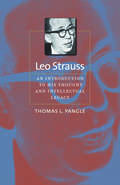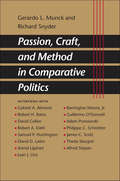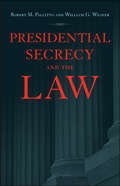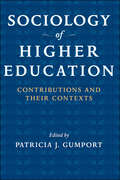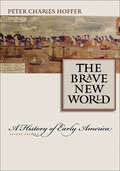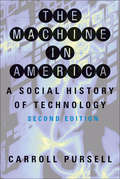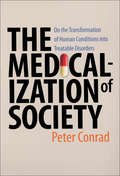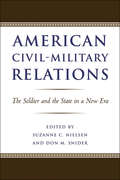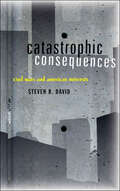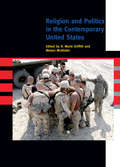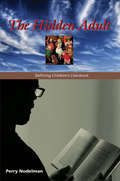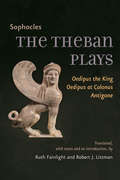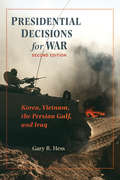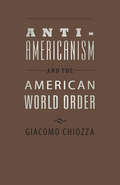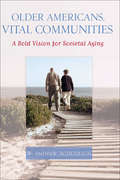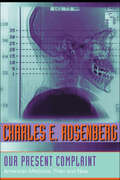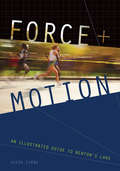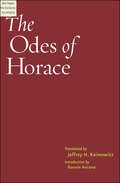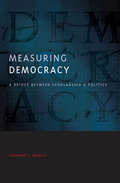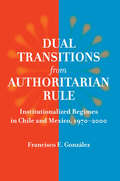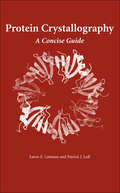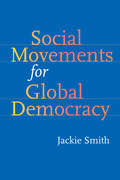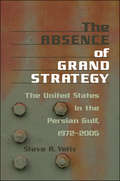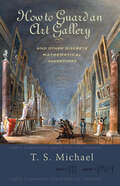- Table View
- List View
Leo Strauss: An Introduction to His Thought and Intellectual Legacy (The Johns Hopkins Series in Constitutional Thought)
by Thomas L. PangleLeo Strauss's controversial writings have long exercised a profound subterranean cultural influence. Now their impact is emerging into broad daylight, where they have been met with a flurry of poorly informed, often wildly speculative, and sometimes rather paranoid pronouncements.This book, written as a corrective, is the first accurate, non-polemical, comprehensive guide to Strauss's mature political philosophy and its intellectual influence. Thomas L. Pangle opens a pathway into Strauss's major works with one question: How does Strauss's philosophic thinking contribute to our democracy's civic renewal and to our culture's deepening, critical self-understanding?This book includes a synoptic critical survey of writings from scholars who have extended Strauss's influence into the more practical, sub-philosophic fields of social and political science and commentary. Pangle shows how these analysts have in effect imported Straussian impulses into a "new" kind of political and social science.
Passion, Craft, and Method in Comparative Politics
by Richard Snyder Gerardo L. MunckIn the first collection of interviews with the most prominent scholars in comparative politics since World War II, Gerardo L. Munck and Richard Snyder trace key developments in the field during the twentieth century. Organized around a broad set of themes—intellectual formation and training; major works and ideas; the craft and tools of research; colleagues, collaborators, and students; and the past and future of comparative politics—these in-depth interviews offer unique and candid reflections that bring the research process to life and shed light on the human dimension of scholarship. Giving voice to scholars who practice their craft in different ways yet share a passion for knowledge about global politics, Passion, Craft, and Method in Comparative Politics offers a wealth of insights into contemporary debates about the state of knowledge in comparative politics and the future of the field.
Presidential Secrecy and the Law
by Robert M. Pallitto William G. WeaverAs seen on The Daily Show, July 24State secrets, warrantless investigations and wiretaps, signing statements, executive privilege—the executive branch wields many tools for secrecy. Since the middle of the twentieth century, presidents have used myriad tactics to expand and maintain a level of executive branch power unprecedented in this nation’s history. Most people believe that some degree of governmental secrecy is necessary. But how much is too much? At what point does withholding information from Congress, the courts, and citizens abuse the public trust? How does the nation reclaim rights that have been controlled by one branch of government?With Presidential Secrecy and the Law, Robert M. Pallitto and William G. Weaver attempt to answer these questions by examining the history of executive branch efforts to consolidate power through information control. They find the nation’s democracy damaged and its Constitution corrupted by staunch information suppression, a process accelerated when "black sites," "enemy combatants," and "ghost detainees" were added to the vernacular following the September 11, 2001, terror strikes.Tracing the current constitutional dilemma from the days of the imperial presidency to the unitary executive embraced by the administration of George W. Bush, Pallitto and Weaver reveal an alarming erosion of the balance of power. Presidential Secrecy and the Law will be the standard in presidential powers studies for years to come.
Sociology of Higher Education: Contributions and Their Contexts
by Patricia J. GumportIn this volume, Patricia Gumport and other leading scholars examine the sociology of higher education as it has evolved since the publication of Burton Clark's foundational article in 1973. They trace diverse conceptual and empirical developments along several major lines of specialization and analyze the ways in which wider societal and institutional changes in higher education have influenced this vital field of study.In her own chapters, Gumport identifies the factors that constrain or facilitate the field's development, including different intellectual legacies and professional contexts for faculty in sociology and in education. She also considers prospects for the future legitimacy and vitality of the field.Featuring extensive reviews of the literature, this volume will be invaluable for scholars and students of sociology and higher education.
The Brave New World: A History of Early America
by Peter Charles HofferThe Brave New World covers the span of early American history, from 30,000 years before Europeans ever landed on North American shores to creation of the new nation. With its exploration of the places and peoples of early America, this comprehensive, lively narrative brings together the most recent scholarship on the colonial and revolutionary eras, Native Americans, slavery, politics, war, and the daily lives of ordinary people. The revised, enlarged edition includes a new chapter carrying the story through the American Revolution, the War for Independence, and the creation of the Confederation. Additional material on the frontier, the Southwest and the Caribbean, the slave trade, religion, science and technology, and ecology broadens the text, and maps drawn especially for this edition will enable readers to follow the story more closely. The bibliographical essay, one of the most admired features of the first edition, has been expanded and brought up to date.Peter Charles Hoffer combines the Atlantic Rim scholarship with a Continental perspective, illuminating early America from all angles—from its first settlers to the Spanish Century, from African slavery to the Salem witchcraft cases, from prayer and drinking practices to the development of complex economies, from the colonies' fight for freedom to an infant nation's struggle for political and economic legitimacy. Wide-ranging in scope, inclusive in content, the revised edition of The Brave New World continues to provide professors, students, and historians with an engaging and accessible history of early North America.
The Machine in America: A Social History of Technology
by Carroll Pursell2008 Outstanding Academic Title, Choice MagazineFrom the medieval farm implements used by the first colonists to the invisible links of the Internet, the history of technology in America is a history of society as well. Arguing that "the tools and processes we use are a part of our lives, not simply instruments of our purpose," historian Carroll Pursell analyzes technology's impact on the lives of women and men, on their work, politics, and social relationships—and how, in turn, people influence technological development.Pursell shows how both the idea of progress and the mechanical means to harness the forces of nature developed and changed as they were brought from the Old World to the New. He describes the ways in which American industrial and agricultural technology began to take on a distinctive shape as it adapted and extended the technical base of the industrial revolution. He discusses the innovation of an American system of manufactures and the mechanization of agriculture; new systems of mining, lumbering, and farming, which helped conquer and define the West; and the technologies that shaped the rise of cities. In the second edition of The Machine in America, Pursell brings this classic history up to date with a revised chapter on war technology and new discussions on information technology, globalization, and the environment.
The Medicalization of Society: On the Transformation of Human Conditions into Treatable Disorders
by Peter ConradOver the past half-century, the social terrain of health and illness has been transformed. What were once considered normal human events and common human problems—birth, aging, menopause, alcoholism, and obesity—are now viewed as medical conditions. For better or worse, medicine increasingly permeates aspects of daily life.Building on more than three decades of research, Peter Conrad explores the changing forces behind this trend with case studies of short stature, social anxiety, "male menopause," erectile dysfunction, adult ADHD, and sexual orientation. He examines the emergence of and changes in medicalization, the consequences of the expanding medical domain, and the implications for health and society. He finds in recent developments—such as the growing number of possible diagnoses and biomedical enhancements—the future direction of medicalization. Conrad contends that the impact of medical professionals on medicalization has diminished. Instead, the pharmaceutical and biotechnical industries, insurance companies and HMOs, and the patient as consumer have become the major forces promoting medicalization. This thought-provoking study offers valuable insight into not only how medicalization got to this point but also how it may continue to evolve.
American Civil-Military Relations: The Soldier and the State in a New Era
by Suzanne C. Nielsen Don M. SniderAmerican Civil-Military Relations offers the first comprehensive assessment of the subject since the publication of Samuel P. Huntington's field-defining book, The Soldier and the State. Using this seminal work as a point of departure, experts in the fields of political science, history, and sociology ask what has been learned and what more needs to be investigated in the relationship between civilian and military sectors in the 21st century.Leading scholars—such as Richard Betts, Risa Brooks, James Burk, Michael Desch, Peter Feaver, Richard Kohn, Williamson Murray, and David Segal—discuss key issues, including:• changes in officer education since the end of the Cold War;• shifting conceptions of military expertise in response to evolving operational and strategic requirements;• increased military involvement in high-level politics; and• the domestic and international contexts of U.S. civil-military relations.The first section of the book provides contrasting perspectives of American civil-military relations within the last five decades. The next section addresses Huntington's conception of societal and functional imperatives and their influence on the civil-military relationship. Following sections examine relationships between military and civilian leaders and describe the norms and practices that should guide those interactions. The editors frame these original essays with introductory and concluding chapters that synthesize the key arguments of the book. What is clear from the essays in this volume is that the line between civil and military expertise and responsibility is not that sharply drawn, and perhaps given the increasing complexity of international security issues, it should not be. When forming national security policy, the editors conclude, civilian and military leaders need to maintain a respectful and engaged dialogue. American Civil-Military Relations is essential reading for students and scholars interested in civil-military relations, U.S. politics, and national security policy.
Catastrophic Consequences: Civil Wars and American Interests
by Steven R. DavidCivil war and other types of radical domestic upheaval are replacing international war as the preeminent threat to American security and economic well being, according to Steven R. David. Catastrophic Consequences argues that civil conflicts are of even greater importance than deliberate efforts to harm the United States because the damage they inflict is unintended and therefore impossible to deter.David examines the prospects for and potential aftereffects of instability in four nations vital to U.S. national interests—Saudi Arabia, Pakistan, China, and Mexico. It is not, he argues, a rising China that threatens America, but one that is falling apart. Likewise, it is not a hostile Pakistani regime over which the United States should worry, rather it is one that cannot keep the country together. Similarly, a conflict-torn Mexico or Saudi Arabia poses a far greater danger to America than does either of those states growing stronger. In assessing these threats, David contends that the United States’s only viable option is to view other-state civil upheaval similarly to natural disasters and to develop a coherent, effective emergency response mechanism, which does not exist today in any systemic, nationwide form.
Religion and Politics in the Contemporary United States (A Special Issue of<I> American Quarterly</I> <I> </I>)
by R. Marie Griffith, Melani McAlisterThis collection of essays from a special issue of American Quarterly explores the complex and sometimes contradictory ways that religion matters in contemporary public life.Religion and Politics in the Contemporary United States offers a groundbreaking, cross-disciplinary conversation between scholars in American studies and religious studies. The contributors explore numerous modes through which religious faith has mobilized political action. They utilize a variety of definitions of politics, ranging from lobbying by religious leaders to the political impact of popular culture. Their work includes the political activities of a very diverse group of religious believers: Christians, Jews, Muslims, Hindus, Buddhists, and others. In addition, the book explores the meanings of religion for people who might contest the term—those who are spiritual but not religious, for example, as well as activists who engage symbols of faith and community but who may not necessarily consider themselves members of a specific religion. Several essays also examine the meanings of secular identity, humanist politics, and the complex evocations of civil religion in American life.No other book on religion and politics includes anything like the diversity of religions, ethnicities, and topics that this one does—from Mormon political mobilization to attempts at Americanizing Muslims in the post-9/11 United States, from César Chávez to James Dobson, from interreligious cooperation and conflict over Darfur to the global politics surrounding the category of Hindus and South Asians in the United States.
The Hidden Adult: Defining Children's Literature
by Perry NodelmanWhat exactly is a children’s book? How is children’s literature defined as a genre? A leading scholar presents close readings of six classic stories to answer these questions and offer a clear definition of children’s writing as a distinct literary form. Perry Nodelman begins by considering the plots, themes, and structures of six works: "The Purple Jar," Alice in Wonderland, Dr. Doolittle, Henry Huggins, The Snowy Day, and Plain City—all written for young people of varying ages in different times and places—to identify shared characteristics. He points out markers in each work that allow the adult reader to understand it as a children’s story, shedding light on ingrained adult assumptions and revealing the ways in which adult knowledge and experience remain hidden in apparently simple and innocent texts.Nodelman then engages a wide range of views of children's literature from authors, literary critics, cultural theorists, and specialists in education and information sciences. Through this informed dialogue, Nodelman develops a comprehensive theory of children's literature, exploring its commonalities and shared themes. The Hidden Adult is a focused and sophisticated analysis of children’s literature and a major contribution to the theory and criticism of the genre.
The Theban Plays: Oedipus the King, Oedipus at Colonus, Antigone (Johns Hopkins New Translations from Antiquity)
by SophoclesSophocles’ Theban Plays—Oedipus the King, Oedipus at Colonus, and Antigone—lie at the core of the Western literary canon. They are extensively translated, universally taught, and frequently performed. Chronicling the downfall of Oedipus, the legendary king of Thebes, and his descendants, the Theban Plays are as relevant to present-day thought about love, duty, patriotism, family, and war as when they were written 2,500 years ago.Recent translations of the plays, while linguistically correct, often fail to capture the beauty of Sophocles’ original words. In combining the skills of a distinguished poet, Ruth Fainlight, and an eminent classical scholar, Robert J. Littman, this new edition of the Theban Plays is both a major work of poetry and a faithful translation of the original works. Thoughtful introductions, extensive notes, and glossaries frame each of the plays within their historical contexts and illuminate important themes, mythological roots, and previous interpretations.This elegant and uncommonly readable translation will make these seminal Greek tragedies accessible to a new generation of readers.
Presidential Decisions for War: Korea, Vietnam, the Persian Gulf, and Iraq (The American Moment)
by Gary R. HessFollowing World War II, Americans expected that the United States would wage another major war against a superpower. Instead, the nation has fought limited wars against much weaker states, such as North Korea, North Vietnam, and Iraq. This revised and updated edition of Presidential Decisions for War analyzes the means by which four presidents have taken the nation to war and assesses the effectiveness of each president's leadership during those conflicts. Gary Hess recreates the unfolding crises in Korea, Vietnam, and Iraq to probe the reasons why Presidents Truman, Johnson, George H. W. Bush, and George W. Bush and their advisors decided in favor of war. He compares the performance of the commanders-in-chief and evaluates how effectively each understood U.S. interests, explored alternatives to war, adhered to constitutional processes, and built congressional, popular, and international support. A new conclusion points out, that unlike the administrations of Truman, Johnson, and the elder Bush, George W. Bush's White House actively sought to change the international order through preemptive war and aggressive democracy building. Fully revised and featuring an examination of how each of the presidents learned from history and juggled the demands on diplomacy, this comparative study of presidential war-making elucidates how effective executive leadership—or its absence—directly affects the outcome of wars.
Anti-Americanism and the American World Order
by Giacomo ChiozzaNews stories remind us almost daily that anti-American opinion is rampant in every corner of the globe. Journalists, scholars, and politicians alike reinforce the perception that anti-Americanism is an entrenched sentiment in many foreign countries. Political scientist Giacomo Chiozza challenges this conventional wisdom, arguing that foreign public opinion about the U.S. is much more diverse and nuanced than is generally believed. Chiozza examines the character, source, and persistence of foreign attitudes toward the United States. His findings are based on worldwide public opinion databases that surveyed anti-American sentiment in Islamic countries, Europe, Latin America, Africa, and East Asia. Data compiled from responses in a wide range of categories—including politics, wealth, science and technology, popular culture, and education—indicate that anti-American sentiments vary widely across these geographic regions. Through careful analyses, Chiozza shows how foreign publics balance the political, social, and cultural dimensions of the U.S. in their own perceptions of the country. He finds that popular anti-Americanism is mostly benign and shallow; deep-seated ideological opposition to the U.S. is usually held among a minority of groups. More often, Chiozza explains, foreigners have conflicting attitudes toward the U.S. He finds that while anti-Americanism certainly exists, the United States is equally praised as a symbol of democracy and freedom, its ideals of liberty, equality, and opportunity applauded. Chiozza clearly demonstrates that what is reported as undisputed fact—that various groups abhor American values—is in reality a complex story.
Older Americans, Vital Communities: A Bold Vision for Societal Aging
by W. Andrew AchenbaumThis thought-provoking work grapples with the vast range of issues associated with the aging population and challenges people of all ages to think more boldly and more creatively about the relationship between older Americans and their communities. W. Andrew Achenbaum begins by exploring the demographics of our aging society and its effect on employment and markets, education, health care, religion, and political action. Drawing on history, literature, and philosophy, Achenbaum focuses on the way health care and increases in life expectancy have transformed late life from a phase characterized by illness, frailty, and debility to one of vitality, productivity, and spirituality. He shows how this transformation of aging is beginning to be felt in programs and policies for aging persons, as communities focus more effort on lifelong learning and extensive civic engagement. Concerned that his own undergraduate students are too focused on the immediate future, Achenbaum encourages young people to consider their place in life's social and chronological trajectory. He calls on baby boomers to create institutional structures that promote productive, vital growth for the common good, and he invites people of all ages to think more boldly about what they will do with the long lives ahead of them.
Our Present Complaint: American Medicine, Then and Now
by Charles E. RosenbergCharles E. Rosenberg, one of the world's most influential historians of medicine, presents a fascinating analysis of the current tensions in American medicine. Situating these tensions within their historical and social contexts, Rosenberg investigates the fundamental characteristics of medicine: how we think about disease, how the medical profession thinks about itself and its moral and intellectual responsibilities, and what prospective patients—all of us—expect from medicine and the medical profession. He explores the nature and definition of disease and how ideas of disease causation reflect social values and cultural negotiations. His analyses of alternative medicine and bioethics consider the historically specific ways in which we define and seek to control what is appropriately medical. At a time when clinical care and biomedical research generate as much angst as they offer cures, this volume provides valuable insight into how the practice of medicine has evolved, where it is going, and how lessons from history can improve its prognosis.
Force and Motion: An Illustrated Guide to Newton's Laws
by Jason ZimbaIsaac Newton developed three laws of motion that govern the everyday world. These laws are usually presented in purely mathematical forms, but Jason Zimba breaks with tradition and treats them visually. This unique approach allows students to appreciate the conceptual underpinnings of each law before moving on to qualitative descriptions of motion and, finally, to the equations and their solutions.Zimba has organized the book into seventeen brief and well-sequenced lessons, which focus on simple, manageable topics and delve into areas that often cause students to stumble. Each lesson is followed by a set of original problems that have been student-tested and refined over twenty years. Zimba illustrates the laws with more than 350 diagrams, an innovative presentation that offers a fresh way to teach the fundamentals in introductory physics, mechanics, and kinematics courses.
The Odes of Horace (Johns Hopkins New Translations from Antiquity)
by Horace (Quintus Horatius Flaccus)2009 Outstanding Academic Title, ChoiceThis groundbreaking new translation of Horace’s most widely read collection of poetry is rendered in modern, metrical English verse rather than the more common free verse found in many other translations. Jeffrey H. Kaimowitz adapts the Roman poet's rich and metrically varied poetry to English formal verse, reproducing the works in a way that maintains fidelity to the tone, timbre, and style of the originals while conforming to the rules of English prosody. Each poem is true to the sense and aesthetic pleasure of the Latin and carries with it the dignity, concision, and movement characteristic of Horace’s writing. Kaimowitz presents each translation with annotations, providing the context necessary for understanding and enjoying Horace's work. He also comments on textual instability and explains how he constructed his verse renditions to mirror Horatian Latin. Horace and The Odes are introduced in lively fashion by noted classicist Ronnie Ancona.
Measuring Democracy: A Bridge between Scholarship and Politics (Democratic Transition and Consolidation)
by Gerardo L. MunckAlthough democracy is a widely held value, concrete measurement of it is elusive. Gerardo L. Munck’s constructive assessment of the methods used to measure democracies promises to bring order to the debate in academia and in practice.Drawing on his years of academic research on democracy and measurement and his practical experience evaluating democratic practices for the United Nations and the Organization of American States, Munck's discussion bridges the theories of academia with practical applications. In proposing a more open and collaborative relationship between theory and action, he makes the case for reassessing how democracy is measured and encourages fundamental changes in methodology. Munck’s field-tested framework for quantifying and qualifying democracy is built around two instruments he developed: the UN Development Programme’s Electoral Democracy Index and a case-by-case election monitoring tool used by the OAS.Measuring Democracy offers specific, real-world lessons that scholars and practitioners can use to improve the quality and utility of data about democracy.
Dual Transitions from Authoritarian Rule: Institutionalized Regimes in Chile and Mexico, 1970–2000
by Francisco E. González2008 Outstanding Academic Title, Choice MagazineLatin America's region-wide 1982 economic collapse had a drastic effect on governments throughout Central and South America, leading many to the verge of failure and pushing several of the most stridently authoritarian—Argentina, Bolivia, Brazil, and Uruguay—over the brink. Surprisingly though, Chile's repressive military dictatorship and Mexico's hegemonic civilian regime endured amid the economic chaos that rocked the region. Dual Transitions from Authoritarian Rule explains why the regimes in these two nations survived the financial upheaval of the early 1980s and how each progressed toward a more open, democratic, market-driven system in later years. Using an in-depth comparative analysis of Chile and Mexico, Francisco González explains that the two governments—though quite different ideologically—possessed a common type of institutionalized authoritarian rule that not only served to maintain the political status quo but, paradoxically, also aided proponents of political and economic liberalization. Featuring a discussion of parallel phenomena in Brazil, Hungary, Taiwan, and South Korea, Dual Transitions from Authoritarian Rule presents a cogent challenge to the received wisdom that sociopolitical and economic change within authoritarian nations must be approached separately. This book will interest scholars of Latin American politics, democratization studies, market reform, and comparative politics and international relations.
Mere Thermodynamics
by Don S. LemonsPresenting classical thermodynamics as a concise and discrete whole, Mere Thermodynamics is a perfect tool for teaching a notoriously difficult subject.Accomplished teacher Don S. Lemons introduces the physical theory's concepts and methods and uses them to solve problems from a broad range of physics. He illustrates, at a gentle pace, not only the fundamentals of the subject but also advanced topics such as the relationship between the second law of thermodynamics and entropy. He highlights the intellectual structure and history of the discipline and explores the logical consequences of each of the famous three laws. Lemons explains and develops the first two laws and their corollaries, the methods and applications of thermodynamics, and the third law, as well as non-fluid variables, equilibrium and stability, and two-phase systems.The book features end-of-chapter practice problems, an appendix of worked problems, a glossary of terms, and an annotated bibliography.
Protein Crystallography: A Concise Guide
by Eaton E. Lattman Patrick J. LollThe proteome remains a mysterious realm. Researchers have determined the structures of only a small fraction of the proteins encoded by the human genome. Crystallography continues to be the primary method used to determine the structures of the remaining unknown proteins. This imaging technique uses the diffraction of X-rays to determine a protein’s three-dimensional molecular structure.Drawing on years of research and teaching experience, Eaton E. Lattman and Patrick J. Loll use clear examples and abundant illustrations to provide a concise and accessible primer on protein crystallography. Discussing the basics of diffraction, the behavior of two- and three-dimensional crystals, phase determination (including MIR and MAD phasing and molecular replacement), the Patterson function, and refinement, Lattman and Loll provide a complete overview of this important technique, illuminated by physical insights.The crisp writing style and simple illustrations will provide beginner crystallographers with a guide to the process of unraveling protein structure.
Social Movements for Global Democracy (Themes in Global Social Change)
by Jackie SmithHonorable Mention, 2010 Book Award, Global Division, Society for the Study of Social ProblemsHonorable Mention, 2010 PEWS Book Award, Political Economy of the World-System section of the American Sociological AssociationThis groundbreaking study sheds new light on the struggle to define the course of globalization. Synthesizing extensive research on transnational activism, Social Movements for Global Democracy shows how transnational networks of social movement activists—democratic globalizers—have worked to promote human rights and ecological sustainability over the predominant neoliberal system of economic integration.Using case studies of recent and ongoing campaigns for global justice, Jackie Smith provides valuable insight into whether and how these activists are succeeding. She argues that democratic globalizers could be more effective if they presented a united front organized around a global vision that places human rights and ecological stability foremost and if they were to directly engage governments and the United Nations.Illuminating the deep-seated struggles between two visions of globalization, Smith reveals a network of activists who have long been working to democratize the global political system.
The Absence of Grand Strategy: The United States in the Persian Gulf, 1972–2005
by Steve A. YetivGreat powers and grand strategies. It is easy to assume that the most powerful nations pursue and employ consistent, cohesive, and decisive policies in trying to promote their interests in regions of the world. Popular theory emphasizes two such grand strategies that great powers may pursue: balance of power policy or hegemonic domination. But, as Steve A. Yetiv contends, things may not always be that cut and dried. Analyzing the evolution of the United States' foreign policy in the Persian Gulf from 1972 to 2005, Yetiv offers a provocative and panoramic view of American strategies in a region critical to the functioning of the entire global economy. Ten cases—from the policies of the Nixon administration to George W. Bush's war in Iraq—reveal shifting, improvised, and reactive policies that were responses to unanticipated and unpredictable events and threats. In fact, the distinguishing feature of the U.S. experience in the Gulf has been the absence of grand strategy.Yetiv introduces the concept of "reactive engagement" as an alternative approach to understanding the behavior of great powers in unstable regions. At a time when the effects of U.S. foreign policy are rippling across the globe, The Absence of Grand Strategy offers key insight into the nature and evolution of American foreign policy in the Gulf.
How to Guard an Art Gallery and Other Discrete Mathematical Adventures
by T.S. MichaelWhat is the maximum number of pizza slices one can get by making four straight cuts through a circular pizza? How does a computer determine the best set of pixels to represent a straight line on a computer screen? How many people at a minimum does it take to guard an art gallery?Discrete mathematics has the answer to these—and many other—questions of picking, choosing, and shuffling. T. S. Michael's gem of a book brings this vital but tough-to-teach subject to life using examples from real life and popular culture. Each chapter uses one problem—such as slicing a pizza—to detail key concepts about counting numbers and arranging finite sets. Michael takes a different perspective in tackling each of eight problems and explains them in differing degrees of generality, showing in the process how the same mathematical concepts appear in varied guises and contexts. In doing so, he imparts a broader understanding of the ideas underlying discrete mathematics and helps readers appreciate and understand mathematical thinking and discovery.This book explains the basic concepts of discrete mathematics and demonstrates how to apply them in largely nontechnical language. The explanations and formulas can be grasped with a basic understanding of linear equations.
